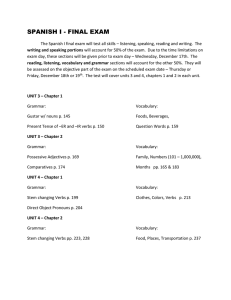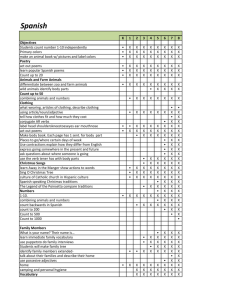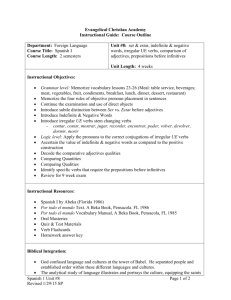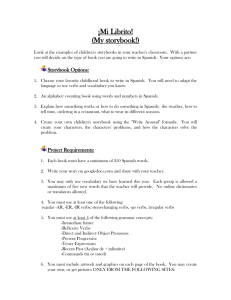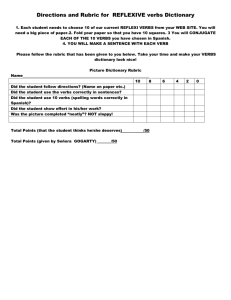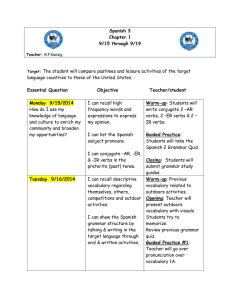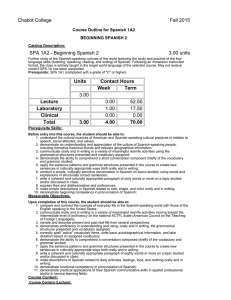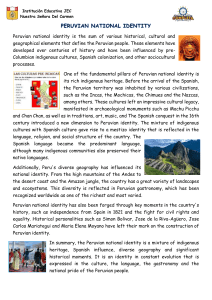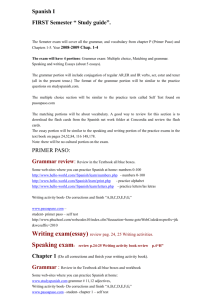Spanish as a Second Language
advertisement
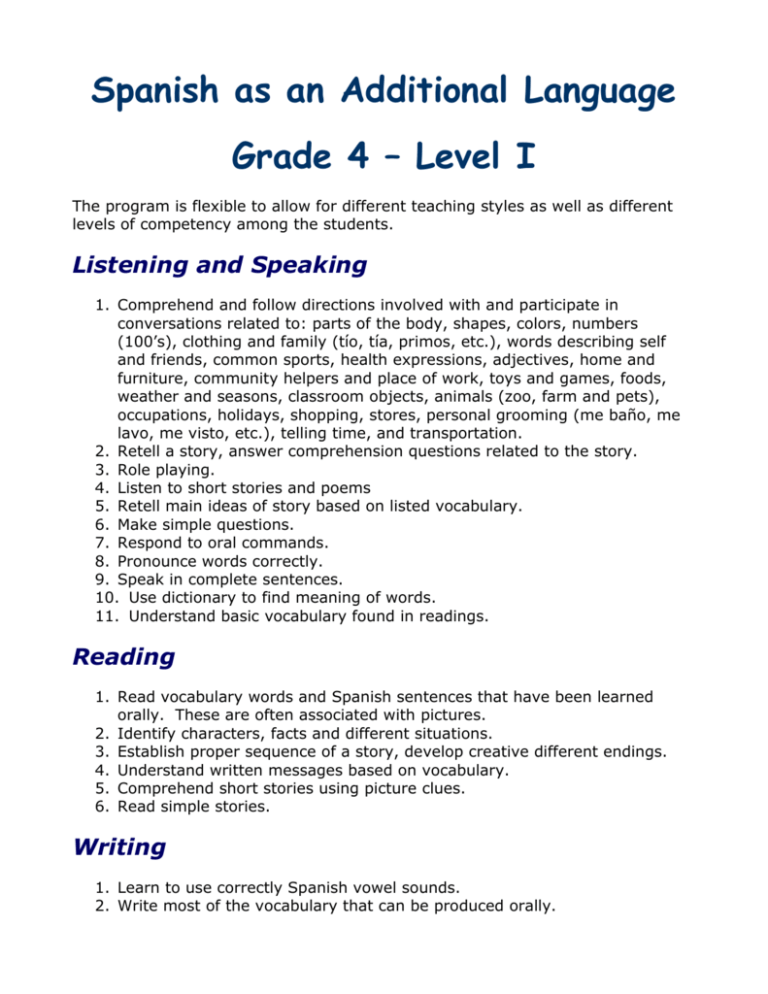
Spanish as an Additional Language Grade 4 – Level I The program is flexible to allow for different teaching styles as well as different levels of competency among the students. Listening and Speaking 1. Comprehend and follow directions involved with and participate in conversations related to: parts of the body, shapes, colors, numbers (100’s), clothing and family (tío, tía, primos, etc.), words describing self and friends, common sports, health expressions, adjectives, home and furniture, community helpers and place of work, toys and games, foods, weather and seasons, classroom objects, animals (zoo, farm and pets), occupations, holidays, shopping, stores, personal grooming (me baño, me lavo, me visto, etc.), telling time, and transportation. 2. Retell a story, answer comprehension questions related to the story. 3. Role playing. 4. Listen to short stories and poems 5. Retell main ideas of story based on listed vocabulary. 6. Make simple questions. 7. Respond to oral commands. 8. Pronounce words correctly. 9. Speak in complete sentences. 10. Use dictionary to find meaning of words. 11. Understand basic vocabulary found in readings. Reading 1. Read vocabulary words and Spanish sentences that have been learned orally. These are often associated with pictures. 2. Identify characters, facts and different situations. 3. Establish proper sequence of a story, develop creative different endings. 4. Understand written messages based on vocabulary. 5. Comprehend short stories using picture clues. 6. Read simple stories. Writing 1. Learn to use correctly Spanish vowel sounds. 2. Write most of the vocabulary that can be produced orally. 3. Write sentenced based on the oral content. 4. Learn to use correctly Spanish syllable sounds (que, qui). 5. Learn to use correctly Spanish consonants (ñ, rr, ll). Grammar 1. 2. 3. 4. 5. Apply grammar concepts to written and spoken language. Subject-verb, article-noun, noun-adjective agreement. Use articles and pronouns. Identify and recognize meaning of antonyms and synonyms. Use of most common verbs, regular and irregular verbs (ser, estar, and ir) and most commonly used reflexive verbs. 6. Use of question and exclamation marks at the beginning and end of a sentence. 7. Demonstrate knowledge of word order. Cultural Awareness 1. Identify Spanish-speaking countries and capitals on a world map. 2. Learn about the main geographical aspects of the Peruvian territory, language, customs, etc. 3. Understand differences among cultures. 4. Learn to adapt to living in Peru. Technology 1. Use technology as a tool for learning and communicating. Spanish as an Additional Language Grade 4 – Level II The program is flexible to allow for different teaching styles as well as different levels of competency among the students. Listening and Speaking 1. Listen to and read simple conversations and respond to comprehension questions. 2. Retell a story, answer comprehension questions related to the story. 3. Participate in small group discussions. 4. Present projects and oral reports. 5. Role playing Reading 1. Informal reading: correspondence, newspaper headings, and advertisements. 2. Read short stories, dialogues, poems, geography and Peruvian history. 3. Identify characters, facts and different situations. 4. Establish proper sequence of a story; develop creative different endings. 5. Identify secondary ideas and details. 6. Identify the most important event in a story. 7. Use of a dictionary to find meaning of words. Writing 1. Encourage creative writing: write scripts for sketches, plays and cartoon stripes, commercial advertisements. 2. Write stories, poems, autobiographical narratives, summaries, etc. 3. Apply the writing process. Grammar 1. 2. 3. 4. 5. Apply grammar concepts to written and spoken language. Subject-verb, article-noun, noun-adjective agreement. Use articles and pronouns and prepositions in context. Identify and recognize meaning of antonyms and synonyms. Use of most common verbs, regular and irregular verbs, gerunds, reflexive verbs. 6. Use of question and exclamation marks at the beginning and end of a sentence. Cultural Awareness 1. Appreciate and value diverse cultural aspects of Latin-American/USA/Peru. 2. Identify Spanish-speaking countries and capitals on a world map. 3. Learn about the main geographical aspects of the Peruvian territory, language, customs, etc.
